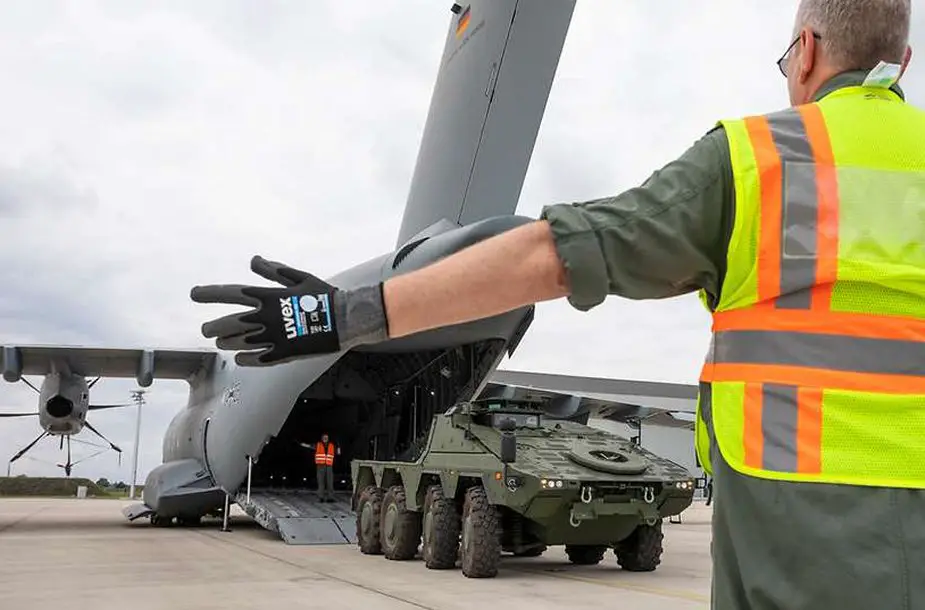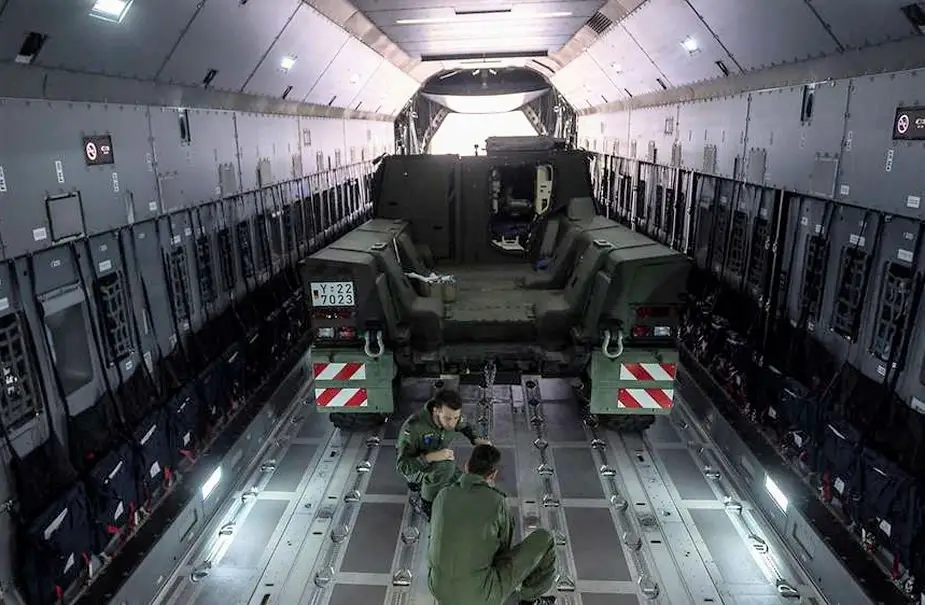The German Air Force’s Lufttransportgeschwader (LTG) 62 (62 Transport Squadron) not only flies : as reported by Sandra Suessmut (Bundeswehr), it develops, tests and improves. More specifically, the technique, tactics, and procedures group does it. In the Cargo Hold Trainer, an image of the Airbus A400M hold, tests are carried out to determine whether a Boxer armored vehicle can be loaded and lashed.
Follow Air Recognition on Google News at this link

Only when the TTVG in Wunstorf gives the green light can the boxer really park in the A400M (Picture spurce : Bundeswehr / Jane Schmidt)
With a rattle, the ten-meter-high louvre door of the hall at the Wunstorf airfield rolls upwards. Behind it, the hall opens to the Cargo Hold Trainer: a true-to-scale simulation of a real cargo hold of the A400M Atlas, the transport aircraft of the LTG 62.
The group for technology, tactics and procedures (TTVG) of the squadron in Wunstorf consists of exactly nine people - and they have a unique job. Every strange or bulky cargo was checked before it was transported: whether the light multipurpose helicopter H145M LUH SOF Light Ulility Helicopter - Special Operation Forces, the marine helicopter Sea Lynx or the combat helicopter Tiger - the team around Sergeant Stefan Schmidt determines the optimal position of the transporter Device, the load factors and the necessary lashing. You always have one thing in mind: safety! Nothing should slip.
Now on the plan: the air transport of the GTK armored transport vehicle Boxer - an armored wheeled vehicle of the German Army. Up until now, it was only brought to a foreign mission by land transport or in the belly of an Antonov An-124, but now the Bundeswehr wants to be able to do it with its own A400M from Wunstorf. A loading inspection is necessary here so that the transport of the armored vehicle Boxer can be approved. The 8x8 vehicle weighs a total of around 35 tons. However, only 32 tons are allowed to drive over the opened ramp of the A400M. The Boxer consists of two elements : the vehicle chassis and the mission module as an attachment. Both are separated from each other for air transport.
The TTVG team of nine people consists of four pilots, two technical loadmasters, two technical officers and one IT information technology officer. Everyone is a specialist in their area of responsibility. The technical loading masters are responsible for the loading examinations.
It is now getting loud in the large Wunstorf hall. The engine of the Boxer was started. One of the armored vehicle's engineers is behind the steering wheel. They carry out all the tests themselves, which is why he personally parks the device, which weighs tons, backwards into the belly of the cargo hold. This precision work takes ten minutes. Then the boxer is lashed with 15 coarse-link chains. There are around 300 eyelets on the floor of the cargo space. The manufacturer of the armored vehicle has drawn up a lashing concept beforehand - which chain, at which point and which component must not be loaded. Whether the theoretical calculations are correct is tested in Wunstorf.

62 TTVG is testing the best parking position in the aircraft so that the Air Force A400M can transport the Boxer to foreign missions in the future (Picture source : Bundeswehr / Jane Schmidt)
In the Cargo Hold Trainer (CHT), the paper lashing plan is implemented in reality. Every centimeter that the boxer covers is documented. After the first attempt, Stefan Schmidt says: "We are already pretty good and that is not the rule." However, it does not stop at just one time. Some chains cannot be attached as planned because a component of the boxer or simply a bolt is in the way. But that's exactly what the men from TTVG, the manufacturer's engineers and a delegation from the OCCAR (Organization Conjointe de Coopération en Matière d’Armement) are there for.
The CHT looks like the cargo compartment of the A400M, but is fundamentally built differently and offers ideal conditions for loading studies.
According to EATC European Air Transport Command regulations, the lashing must be able to withstand a multiple of the weight of the boxer. In the case of the boxer, that means that the vehicle is fixed in the simulator as if it weighed 75 tonnes instead of the actual 25 tonnes. Another example: passengers in scheduled aircraft have to be protected by law with a factor of 16. In other words: One person could be 16 times as heavy - the seat belt in a civil aircraft would hold. Centrifugal forces accelerate any weight. Golden rule in Wunstorf: the lashing chain is likely to deform, but never break.
In the future, after certification, two Boxers with three A400Ms will be able to fly abroad. One chassis per aircraft and two mission modules in the third.
Oberstabsfeldwebel Walther used to be a member of the TTVG himself. Today he is in quality management. He is a veteran in testing in Wunstorf. He concludes: “We are only dealing with the load here because the aircraft is so new and the loads have not yet been adjusted. It's just not the Transall. At some point we will move away from charge testing and towards process improvement. This is what the V in our name stands for. Improving procedures for dropping parachutists or tactical flying, for example. But we're not there yet. "
















